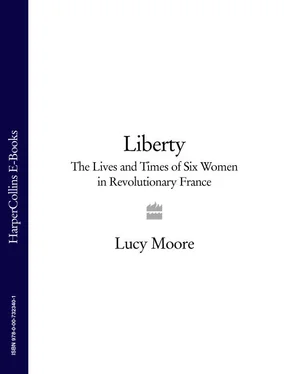Part of the reason for this is the hidden currents lying beneath the surface of Rousseau's work. Although he told women they should be subservient to men, his heroines were in fact often more capable and passionate than the men in their lives. In Émile, ou De l'éducation , Sophie ‘sought a man and…found monkeys’. When Émile falls in love with her, he recognizes that she must be his guide, just as in La Nouvelle Héloïse Julie tells Saint-Preux that she will direct their common destinies. For all its melancholia and high-mindedness—Germaine said that he had made ‘a passion of virtue’—Rousseau's writing was also thrillingly erotic. He himself said his books ‘can only be read with one hand’.
The duality in his books echoed that in his life. Although he idealized motherhood, Rousseau abandoned his own children; although he wrote about pure, innocent love he openly admitted to masochism and masturbation; although he praised submissive women his own first mistress, with whom he lived in a ménage à trois alongside her herbalist, was a speculator, adventuress and sometime spy. His Confessions , published posthumously, revealed vanity, vices and frailties but only added to his appeal.
While he explicitly excluded women from political life, Rousseau's writings inadvertently made women political creatures. They may have read his works for pleasure, but they also found in them rejections of tyranny and pleas for justice so persuasive that they came to believe the inequalities and constraints of society that they had once unquestioningly accepted were absurd.
Rousseau's philosophy, both public and private, set the tone for salons like Germaine's of the late 1780s. Her circle rejected the ancien régime world for its hollowness, its arbitrariness and its superficiality. ‘It laughs at all those who see the earnestness of life and who still believe in true feelings and serious thought,’ she lamented later. ‘It soils the hope of youth.’ The French, she said, were ‘too civilised in some respects’, their rigmarole of manners and conventions grading ‘people instead of uniting them’.
But while Germaine's salon was notable for its liberalism and lack of prejudice, and welcomed newcomers if they had something to offer, its habitués were largely drawn from a small group of aristocrats who, in Germaine's words, ‘preferred the generous principles of liberty to the advantages which they enjoyed personally’. Despite her democratic ideas, Germaine lived and entertained on an almost royal scale: two rows of footmen flanked the anteroom through which her fashionably free-thinking guests entered the gold and marble salon. Victorine de Chastenay was thinking of Germaine's friends when she said that at the start of the revolution the most progressive nobles were generally ‘not the provincial gentry and those least qualified, but the most brilliant youth, men whose families had been the most loaded with gifts and honours at the Court’. ‘It was the fashion to complain of everything,’ wrote one of the queen's ladies-in-waiting. ‘Unnoticed, the spirit of revolt was rampant in all classes of society.’
Many of Mme de Staël's friends had served in the American army during the late 1770s and early 1780s when the French government supported the United States against the British (the burden of its spending there precipitating the financial crisis of the mid-1780s) and saw in the United States a republican idyll of freedom, simplicity and virtue. The marquis de Lafayette had fought beside George Washington and considered him his adoptive father. He and Washington were also united by their freemasonry, one means by which the enlightenment philosophies that inspired the revolution were disseminated; the writer Louis-Sébastien Mercier called masons' lodges in the 1780s ‘a kind of school for oratory’. Germaine remarked that the love of liberty ‘decided every action’ of Lafayette's life.
Another idealistic American veteran was Mathieu de Montmorency, a friend of Lafayette's and a prominent member of the Estates-General, who demanded a Declaration of Rights and happily relinquished his aristocratic privileges in August 1789. A year later, he called for the abolition of titles themselves and all marks of nobility, like servants in livery and coats of arms on carriages, façades and church pews. ‘All Frenchmen shall wear from henceforth the same ensigns,’ he declared, ‘those of Liberty.’ Like Germaine he looked on Rousseau as a hero, petitioning for him to be honoured by the French nation in 1791.
As well as Frenchmen who had served in America, Germaine knew several Americans in Paris, including Thomas Jefferson (who advised Lafayette on his drafts of the Declaration of the Rights of Man and the Citizen before leaving Paris in September 1789) and Tom Paine. One of her most regular American guests was Gouverneur Morris, who admitted he felt very stupid in the rue du Bac. His pursuit of Talleyrand's mistress did not stop him making eyes at the wild, enchanting Aimée de Coigny. ‘We have some little compliments together, Mme de Coigny and I,’ he confided to his diary after a dinner in 1791 at Lady Sutherland's,—the British ambassadress was another member of Germaine's set,—‘and I think it possible we may be pretty well together, but this depends on the Chapter of Accidents for she must be at the Trouble of bringing it about. Stay late here.’
Morris was not entirely in agreement with the politics of Ger-maine's salon. Soon after his arrival in Paris in early 1789 he described Germaine's friend and Lafayette's cousin Mme de Tessé, a member of the queen's household, as a republican ‘of the first feather’; a week later he was told her friends saw him as an ‘aristocrat’, with ideas ‘too moderate for that company’. This was partly true. Morris thought the French too depraved for liberty—but perhaps he was simply intoxicated by the pleasures of the ancien régime and did not want them replaced by republican austerity before he had drunk his fill.
The most radical aristocrat of Staël's group was the marquis de Condorcet, a mathematician and philosopher. Reserved and painfully timid, Condorcet lacked social polish—he was said always to have hair-powder in his ears—but his passion for modernity illuminated his views. The first stirrings of reform confirmed all his faith in the perfectibility of mankind. ‘Everyone tells us that we are bordering the period of one of the greatest revolutions of the human race,’ he wrote optimistically. ‘The present state of enlightenment guarantees that it will be happy.’
Condorcet, married to a celebrated intellectual (and another celebrated salonnière) twenty-one years his junior, Sophie de Grouchy, known as la Vénus lycéenne , was one of the rare feminists of the age. In his political writings of the late 1780s he called repeatedly for the franchise, when it came, to be extended to women as well as men. ‘Either no individual in humankind has genuine rights,’ he declared in On the Admission of Women to Civil Rights in July 1790, ‘or all have the same ones.’ Excluding women from political life, he argued, violated the entire principle of natural rights on which the first revolutionaries were basing their calls for reform. The right to participate in the government of their country is a right men hold by virtue of their reason, not their gender; thus women, who also possess reason, cannot be deprived of those rights. Furthermore, he insisted, women's active contribution to society could only be of benefit to it.
According to the historian Madelyn Gutwirth, Condorcet was so concerned to avoid the ‘posture of bogus rococo gallantry’ that marked so much eighteenth-century writing about women that he lamented his lack of it. ‘Sighing philosophically, he observes that in robbing women of their myth by speaking of their “rights rather than their reign”, he may fail to earn their approval, for he saw all about him the stampede among women to Rousseauist views’, which granted them dominion over men's hearts but no political rights.
Читать дальше












